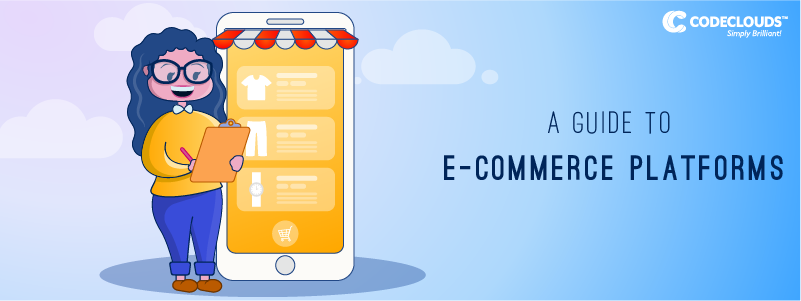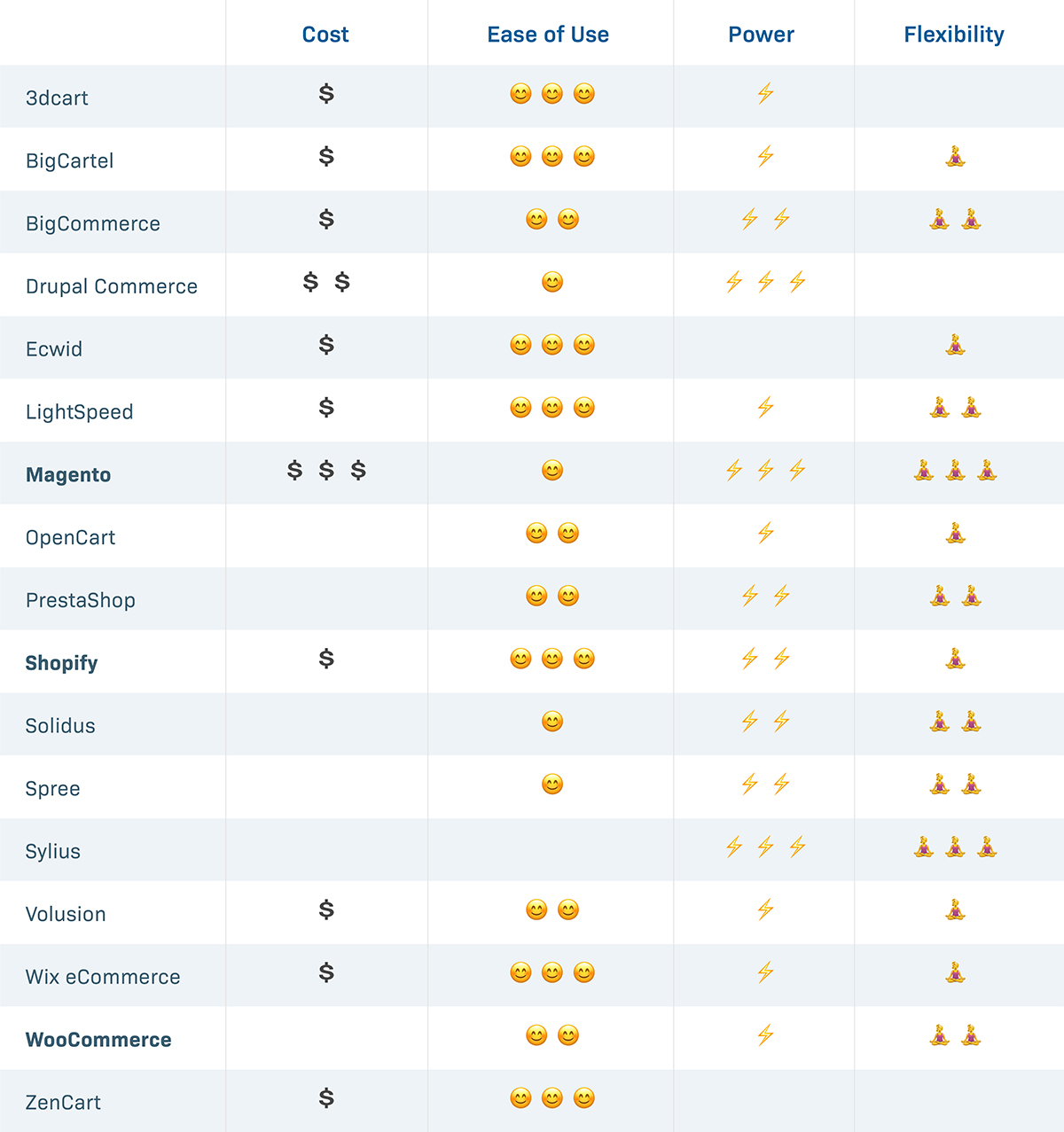Overview
There are a lot of options when you need to choose an eCommerce platform, but most guides cut off after the top three: Magento, Shopify and WooCommerce. We’re going to go deeper than that, and hopefully highlight some lesser-known eCommerce management systems. Don’t worry though: we’ll give the big three their time in the spotlight. Skip to the bottom for a table summarising our thoughts.

The Three Kings
In the early 2010s it seemed like there were 1000s of eCommerce platforms, but in the last decade, the industry has consolidated around only three. These platforms account for 70% of eCommerce storefronts on the entire internet.
Magento
Heavy, powerful, expensive. More than once, I’ve heard Magento compared to a tank. The go-to platform for enterprise-level clients, and hard to match in terms of raw power. Magento is notoriously difficult to develop and takes a skilled developer to get the most out of—it runs on Zend PHP, which is a dense framework designed from the ground-up for enterprise clients. Ford uses Magento. So do Nike, Procter & Gamble, and 3M.

Magento isn’t recommended for small businesses just coming out the gate, but if you want to take things to the next level then it’s absolutely where you want to be. If this is you, CodeClouds’ Magento eCommerce customization services are here to help.
There is a free version (Magento Open Source) but it lacks most of the features that make Magento popular in the first place. It’s a good place for developers to learn to use the system and it’s a nice way to get familiar with Zend, but you’re coming to Magento because you want to go big, and there’s no point pulling the punch.
The CodeClouds Emojimeter rates cost, ease of use, power and flexibility and it says: 💲💲💲 😊 ⚡⚡⚡🧘🧘🧘
Shopify
Where Magento dominates the top-end, Shopify is the nimble little platform preferred by mom-and-pop stores, graduates and new startups. Shopify is very easy to use, and you can build a store with no coding knowledge whatsoever. It runs a SaaS model with monthly charges which include the cost of hosting, support and all the little technical things that can trip you up.
While Magento is purpose-built for major companies, Shopify is purpose-built for the average user who doesn’t know much about computers and doesn’t want to have to. That’s both its strength and its weakness: it’s very good at holding your hand but hard to make it let go. If you want to do something more ambitious with your Shopify store, you’re going to need to call in outside technical support. Shopify used to have Mailchimp integration, but they’re recently split.
The emojis say: 💲😊😊😊⚡⚡🧘
WooCommerce
The free option out of the big 3, though like most free options it requires you to provide your own hosting and support. We’ve done a comparison of WooCommerce vs Shopify before but the short version is this: it initially looks cheaper than Shopify, but ends up being more expensive once you factor in everything a Shopify subscription provides. It’s still relatively cheap, especially compared to a heavy-hitter like Magento. It integrates seamlessly with your WordPress blog or CMS and can be great if you’ve already got an established WP presence.
Or, in emoji: 😊😊⚡🧘🧘
The Free Markets
These platforms are all open-source, and totally free. They require a little more tech know-how to wrangle but in terms of cost/utility they are powerful tools that give the skilled developer an unprecedented degree of control. These are the absolute best picks if you’re a developer yourself, or if you know one who will work for cheap.
PrestaShop
You’re going to need to provide your own hosting for PrestaShop, and its UI isn’t as easy to use as a paid competitor like Shopify, but it’s powerful and doesn’t cost a cent. Robust, if a little finicky.
😊😊⚡⚡🧘🧘
Sylius
The only platform that can get anywhere near Magento in terms of power. Sylius runs on a PHP framework called Symfony, which is often cited as the single biggest competition for Zend. Symfony can be harder to use then Zend, but senior developers love it, and it’s got the edge for enterprise solutions. Sylius is Symfony more than any other platform is the language its written in—you’re going to need to understand the code a lot better if you want to get anything done. If you can do all that though, Sylius gets absolutely rave reviews. It has the power of Magento but runs a lot more smoothly. It is free, though retaining a full-time Symfony developer isn’t going to come cheap.
⚡⚡⚡🧘🧘🧘
Solidus/Spree
Two variants of the same platform, one “forked” off the other. They both run off Ruby on Rails. Fully off Ruby on Rails too—Shopify often gets called an RoR system but really that’s just the templating engine. These are smaller platforms that are difficult to customise.
😊⚡⚡🧘🧘
OpenCart
OpenCart is the easiest of the open-source platforms to use and customize, and requires relatively little skill with code. There are a wide variety of extensions available, some of varying quality. Support can be patchy, and the community seems a little fragmented.
😊😊⚡🧘
BigCartel
Not open-source, but with a free tier that’s exceptionally popular with small businesses. While most platforms have a free tier, BigCartel is known for its free tier: it’s powerful and flexible compared to the competition. Requires very little code knowledge. BigCartel is a common starting point for new shops, though most developers recommend moving away from it around the time you’d be looking at going onto a tiered plan—it’s a great way to test out the viability of an idea, or simply to run a smaller local store.
💲😊😊😊⚡🧘
The Specialists
These are decent middle-of-the-road systems with one particular job they do very well. You’re not going to get the world from them, but if your focus is in one particular place then they’re worth your attention.
LightSpeed eCommerce
Traditionally a POS provider, LightSpeed have moved into eCommerce with their own CMS. Integrates well with their devices and might be a good pick for brick-and-mortar stores already using their POS machines. It’s split into a whole lot of smaller industry modules, and some have been better-received than others—the food service module in particular seems to have attracted some negative buzz. Check with other retailers and see how well they’ve been liking this one.
💲😊😊😊⚡🧘🧘
BigCommerce
When people talk favourably about BigCommerce, they tend to point to its SEO capabilities. If getting onto the front page of Google is a major concern for you, then this is one to look into. It’s a respectable platform outside of that, though nothing revolutionary: it does a decent job in all areas, and an excellent job at SEO.
💲😊😊⚡⚡🧘🧘
The Mods
These are not dedicated platforms, they’re changes you can make to an existing platform to turn it into a storefront.
Wix eCommerce
Like WooCommerce, this isn’t really a storefront: it’s a blog platform that lets you build storefronts. Wix sets its sights a little more broadly than WC, and aims to be a simple WYSIWYG site editor for people with no code background—it’s better-suited to commerce because they built it to accept commerce plugins from day 1. Very easy to use, low startup cost, good for newcomers. Like Shopify, it has the issue of being a walled garden, and I’m not sure it’s possible to knock down the walls in this case. Its accessibility makes it a viable player at the low-end game.
💲😊😊😊⚡🧘
Ecwid
Ecwid isn’t a full eCommerce platform, it’s a widget for WordPress, almost like WooCommerce lite—it’ll give an existing WP site basic no frills eCommerce functionality. It’s not a great pick when building a store from the ground up, but could be good if you’re looking to extend an existing WordPress site into the eCommerce sphere.
💲😊😊😊🧘
The Old Guard
These platforms have all been titans in their time, but they’ve dropped off the radar for various reasons as the market centralised around the big 3. They’re still available if you want something tried-and-tested.
Drupal Commerce
Drupal is still huge as a general CMS, but the company’s attempt at an eCommerce CMS stumbled in the early-mid 2010s and never quite recovered. If you’re running a storefront that’s part of a larger organisation and that organisation runs Drupal, this is a great option for easy integration and for saving difficulty and overhead on getting an army of developers for your different platforms.
💲💲😊⚡⚡⚡
Volusion
Volusion is similar to Shopify in terms of style and price, though it’s a bit dated and lacks a lot of modern features—in particular, it can’t match the Shopify WYSIWYG editor that makes sitebuilding so easy. What is does have going for it is absolutely no transaction fees. Particularly if you’re selling high-volume/low-cost, Volusion has a financial edge over Shopify. It also has a robust set of data tools to help you understand your customers better than the competition.
💲😊😊⚡🧘
3dcart
Once very popular, but now suffering. Very good at caching user data and setting up dropped-cart and followup systems but lacks proper social media integration. Facebook integration is still in beta, though development is slow. Has reported issues with AMP and responsive web pages, and other web apps.
💲😊😊😊⚡
ZenCart
Absolutely the biggest market player circa 2005, now mostly forgotten. The community is dead, and updates are sluggish. A lot of older marketers will still recommend this because it’s what they started on and they have good memories of it, but I really wouldn’t recommend it in 2019. Pick ZenCart for nostalgia only.
💲😊😊😊
The Conclusion
There’s a reason the big three are the big three, but it can’t hurt to know your options. Maybe you run a dozen brick-and-mortar stores all running LightSpeed, or maybe your spouse is a skilled PHP developer looking to stretch themselves, and Sylius has caught your attention. To really boil things down, we’ve created a chart to help you make your final decision:

If you happen to decide on Magento, Shopify, WooCommerce or Drupal, then we’ve got teams of great eCommerce developers in the US, India and New Zealand. We’re eCommerce specialists and we’re experienced at remote work. Get in touch with us today!
Share this article
161 reads
Similar Reads








